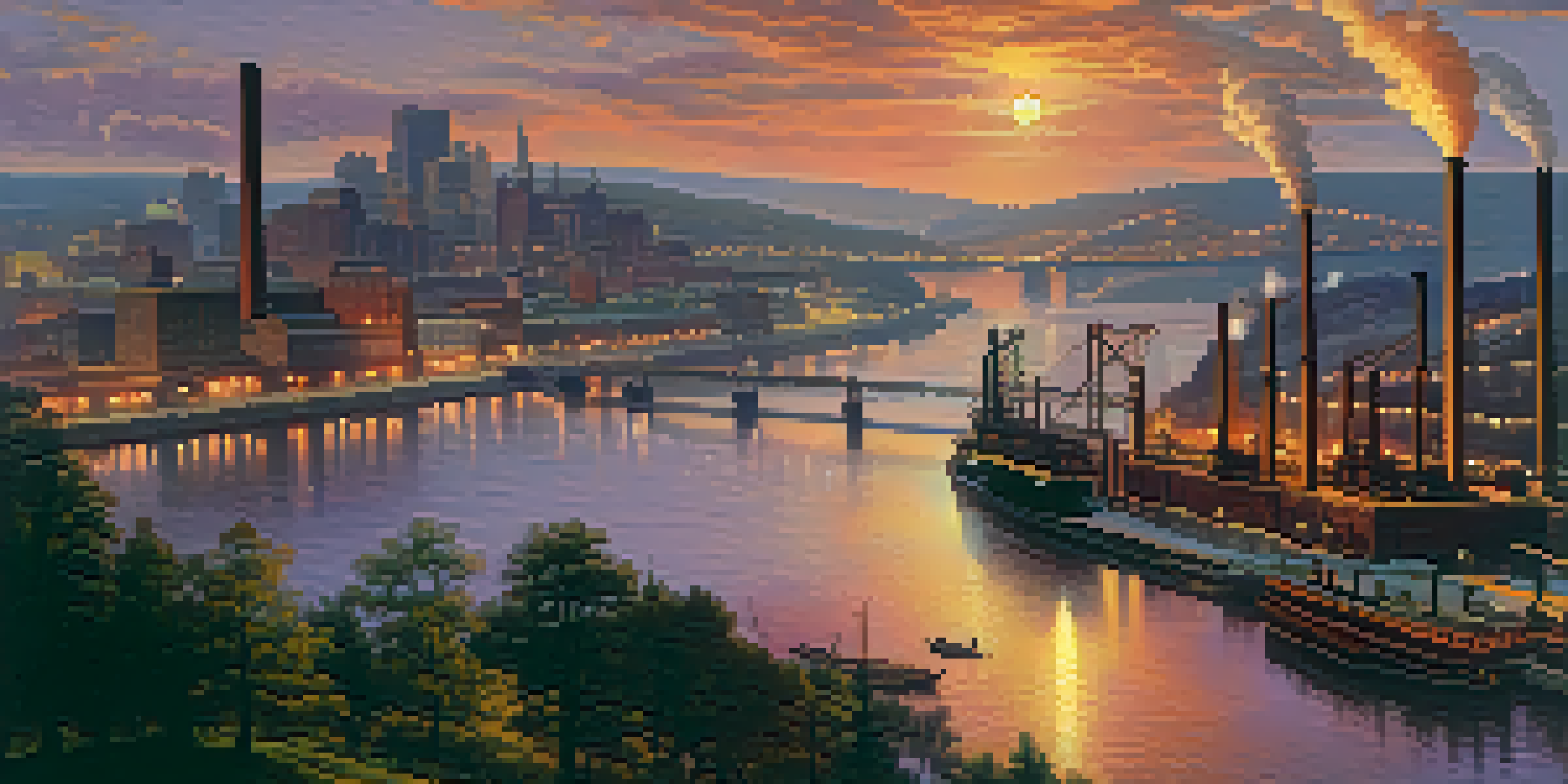The Steel City: Key Figures Who Shaped Pittsburgh's Industry

Andrew Carnegie: The Steel Magnate of Pittsburgh
Andrew Carnegie stands as one of the most iconic figures in Pittsburgh's industrial history. Born into a poor family in Scotland, he immigrated to the United States and quickly rose through the ranks of the railroad industry. His vision and ambition led him to establish Carnegie Steel, which revolutionized steel production and contributed to the city's booming economy.
The man who acquires wealth, and enjoys it, must be the happiest man in the world.
Under Carnegie's leadership, the company adopted innovative manufacturing techniques, including the Bessemer process, which enabled mass production of steel. This not only made steel more affordable but also fueled the construction of railroads and skyscrapers across America. Carnegie’s investments helped transform Pittsburgh into the 'Steel City', a hub of industry and commerce.
Philanthropy was also a significant part of Carnegie's legacy. After selling his steel company, he dedicated his wealth to various causes, including libraries, education, and peace initiatives. His commitment to giving back has left a lasting impact on both Pittsburgh and the world.
Henry Clay Frick: The Ruthless Industrialist
Henry Clay Frick played a pivotal role in Pittsburgh's industrial narrative, often seen as Carnegie's right-hand man. As the chairman of Carnegie Steel, Frick was instrumental in expanding the company and implementing strict labor policies that would later lead to significant labor conflicts. His aggressive tactics, while effective in increasing productivity, often drew criticism and created a contentious atmosphere.

Frick's most notorious moment came during the Homestead Strike of 1892, a violent labor dispute that highlighted the tensions between industrialists and workers. Frick's decision to lock out union workers and hire private security led to deadly confrontations, marking a turning point in labor relations in the United States. This event not only shaped the future of labor rights but also Frick's reputation as a controversial figure.
Carnegie's Steel Transforms Pittsburgh
Andrew Carnegie's innovations in steel production revolutionized the industry and established Pittsburgh as the 'Steel City'.
Despite his ruthless business practices, Frick also contributed to Pittsburgh's cultural landscape. He invested in the arts, founding the Frick Art & Historical Center, which showcases his collection of fine art and historical artifacts. His dual legacy as both an industrial titan and a patron of the arts reflects the complexity of Pittsburgh's industrial era.
George Westinghouse: The Innovator of Electricity
George Westinghouse emerged as a key player in Pittsburgh's industrial scene, particularly in the field of electricity. His invention of the air brake revolutionized the railroad industry, making trains safer and more efficient. This early success laid the groundwork for his later ventures in electrical engineering, where he competed against Thomas Edison in the battle for electrical dominance.
We must be willing to get rid of the life we've planned, so as to have the life that is waiting for us.
Westinghouse's vision extended beyond railroads; he was a proponent of alternating current (AC) electricity, which ultimately became the standard for power distribution. His partnership with Nikola Tesla led to groundbreaking developments that transformed how electricity was generated and transmitted. This innovation not only changed Pittsburgh but also impacted cities across the globe.
In addition to his engineering feats, Westinghouse was committed to fair labor practices and believed in providing a better working environment for his employees. His legacy includes not just technological advancements, but also a more humane approach to industry, setting a precedent for future business leaders in Pittsburgh.
John Heinz: The Businessman with a Vision
John Heinz is a name synonymous with Pittsburgh, not just for his iconic food brand but also for his contributions to the local economy. He founded Heinz & Noble in 1869, which later evolved into the H.J. Heinz Company, famous for its ketchup and other food products. His commitment to quality and innovation helped establish Pittsburgh as a center for food manufacturing.
Heinz was a pioneer in marketing and branding, understanding the importance of connecting with consumers. His focus on quality not only set his products apart but also raised industry standards. This approach not only benefited his company but also influenced other businesses in the region to prioritize quality and consumer engagement.
Frick's Dual Legacy in Industry
Henry Clay Frick's controversial labor practices and contributions to the arts illustrate the complexities of Pittsburgh's industrial era.
Beyond his business acumen, Heinz was also a dedicated philanthropist. He invested in community initiatives and advocated for social causes, emphasizing the importance of corporate responsibility. His legacy continues to inspire local businesses, reminding them of the impact they can have on their communities.
David Lawrence: The Politician Who Fostered Growth
David Lawrence, a prominent political figure in Pittsburgh, played a crucial role in the city's post-war industrial growth. Serving as mayor from 1946 to 1959, he implemented policies aimed at revitalizing the city and attracting new industries. His vision included infrastructure improvements and urban development initiatives that laid the foundation for Pittsburgh's future.
Lawrence's tenure was marked by a commitment to modernization, as he sought to transform Pittsburgh from its steel-centric economy to a more diversified one. He encouraged the growth of technology and education sectors, recognizing the need for innovation in an evolving industrial landscape. His efforts helped to position Pittsburgh as a center for education and research.
His legacy extends beyond economic development; Lawrence was also an advocate for civil rights and community engagement. He believed in a united Pittsburgh, where all residents could thrive. His approach to governance and community involvement continues to resonate in the city's political landscape today.
Andrew Mellon: The Banking Baron and Philanthropist
Andrew Mellon was not just a financier; he was a key architect of Pittsburgh's industrial landscape. As a banker and investor, he played a significant role in financing various industries, including steel, coal, and railroads. His financial influence helped fuel the growth of Pittsburgh's economy during the late 19th and early 20th centuries.
Mellon's impact extended beyond banking; he was also a prominent philanthropist. He donated substantial sums to cultural institutions, including the National Gallery of Art in Washington, D.C., and the Carnegie Mellon University, which reflects his commitment to education and the arts. His contributions helped shape Pittsburgh's cultural identity and provided resources for future generations.
Carson's Environmental Advocacy
Rachel Carson's work spurred a national environmental movement, demonstrating the impact of industrial practices on nature.
Despite his wealth and power, Mellon was known for his low-key demeanor and pragmatic approach to business and philanthropy. He exemplified the idea of using wealth for the greater good, emphasizing the importance of giving back to the community. His legacy continues to inspire those in Pittsburgh and beyond to make a positive impact through philanthropy.
Rachel Carson: The Environmental Pioneer
Rachel Carson, born in Pennsylvania, became a global figure in the environmental movement, with roots tracing back to Pittsburgh. While not an industrialist in the traditional sense, her work highlighted the impact of industrial practices on nature. Her groundbreaking book, 'Silent Spring', raised awareness about the dangers of pesticides and their effect on ecosystems, sparking a nationwide environmental consciousness.
Carson's writing combined scientific research with compelling storytelling, making complex environmental issues accessible to the public. Her advocacy for conservation and responsible practices challenged industries to reconsider their approaches and the consequences of their actions. This shift in perspective paved the way for future environmental regulations and movements.

Her legacy is a testament to the power of one individual to effect change. Carson's influence extends beyond Pittsburgh, as she inspired generations of environmentalists and policy-makers to prioritize the health of our planet. Her work reminds us that industrial progress and environmental stewardship can coexist with thoughtful consideration.
Conclusion: Celebrating Pittsburgh's Industry Shapers
The figures who shaped Pittsburgh's industrial landscape each brought unique contributions that transformed the city into a powerhouse. From Andrew Carnegie's steel empire to George Westinghouse's innovations in electricity, these individuals played pivotal roles in defining what Pittsburgh is today. Their legacies are woven into the fabric of the city, influencing both its economy and culture.
As we reflect on these key figures, it's essential to recognize the complexities of their stories. Each faced challenges and controversies, but their impact is undeniable. Their lives serve as reminders that innovation, resilience, and community engagement are vital in shaping our environment.
Pittsburgh continues to evolve, drawing inspiration from its rich history. By honoring the contributions of these industrial pioneers, we can foster a future that embraces both progress and responsibility, ensuring that the Steel City remains a vibrant hub of industry and innovation.